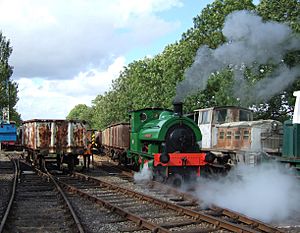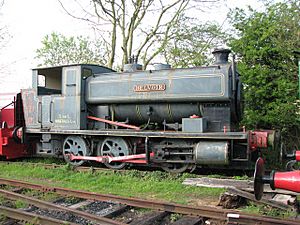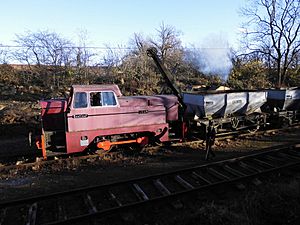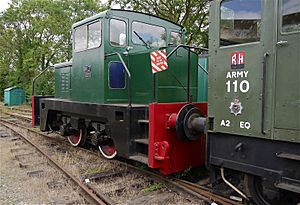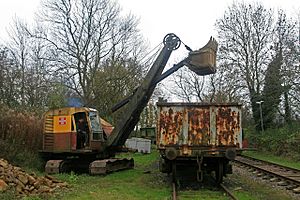Rutland Railway Museum facts for kids

Andrew Barclay "Sir Thomas Royden" with a train of mineral wagons.
|
|
| Location | Cottesmore, Oakham, Rutland |
|---|---|
| Type | Railway museum |
Rocks by Rail: The Living Ironstone Museum, also known as Rutland Railway Museum, is a special railway museum in Rutland, England. It's built on part of an old railway line that used to carry minerals. You can find it northeast of Oakham.
Contents
Discovering Rocks by Rail
This museum is outdoors and shows you how iron ore was dug up and moved long ago. It's like stepping back in time to see a real ironstone railway system. The museum wants to save and run old trains and wagons that worked in local quarries. They also collect other cool items from these old railway systems.
The museum looks like a typical quarry system from the 1950s or early 1960s. Back then, both steam and diesel trains were used in the industry. The railway line here connected to the main railway line at Ashwell Signal Box. This spot was once a busy place where three different private quarry railways met. People locally called it Cottesmore Iron Ore Mines Sidings.
What You Can See at the Museum
The museum has saved some interesting old structures. These include a concrete tipping dock from Cottesmore quarries. There's also a building where locomotives were kept, brought from Woolsthorpe Quarries.
You can also see several large quarry machines. These include:
- A 22RB Ruston-Bucyrus shovel, used for digging.
- A 22RB Ruston-Bucyrus dragline excavator, another type of digging machine.
- A Euclid dump truck, like those used in local quarries.
The museum even has parts of giant machines! You can see the driver's cab from the huge Ransomes & Rapier dragline excavator called Sundew. There's also a cab from another big dragline, the 110RB Ruston-Bucyrus, which came from the Barrington Cement Works quarry.
The museum also has the Simon Layfield Exhibition Centre. This building has three tracks filled with old trains and wagons. It also features displays about the history of local quarry railways.
The Story of "SINGAPORE"
One special train on display is the Hawthorn Leslie locomotive named "SINGAPORE." It was built in 1936. This train was sent to the Royal Navy Dockyard in Singapore. During World War II, it was captured by the Japanese in 1942.
"SINGAPORE" has bullet and shrapnel damage from air raids during the war. This makes it a very important piece of history. The locomotive "SINGAPORE" is an honorary member of the FEPOW organization. It is also a registered War Memorial.
The museum offers rides on a track that is about 0.75 miles long. The whole museum covers nearly 9 acres. You can ride in restored brake vans, which are like the cabooses used on old freight trains. The museum is always happy to receive donations of old items or information to help them learn more.
Amazing Locomotives
The museum has many different types of old trains, both steam and diesel.
Steam Locomotives
- Hawthorn Leslie "SINGAPORE" (built 1936): This 0-4-0ST locomotive is on display. It needs funds to be restored to working condition. It served in Singapore and Chatham Dockyards.
- Andrew Barclay (built 1927): This 0-4-0ST locomotive is currently working! It used to work for British Sugar.
- Andrew Barclay "SIR THOMAS ROYDEN" (built 1940): This 0-4-0ST locomotive is on display.
- Andrew Barclay "BELVOIR" (built 1954): This 0-6-0ST locomotive is on display. It worked in Woolsthorpe quarries.
- Avonside "STAMFORD" (built 1927): This 0-6-0ST locomotive is on display, waiting to be restored. It worked in Pilton quarries.
- Peckett & Sons "UPPINGHAM" (built 1912): This 0-4-0ST locomotive is on display, waiting for restoration.
- W.G. Bagnall "CRANFORD No. 2" (built 1942): This 0-6-0ST locomotive is on display.
- Yorkshire Engine Company (built 1952): This 0-6-0ST locomotive is on display.
- Peckett & Sons "ELIZABETH" (built 1928): This 0-4-0ST locomotive is being fully restored.
- Hudswell Clarke "RHOS" (built 1918): This 0-6-0ST locomotive is taken apart and waiting for restoration.
Diesel Locomotives
- Yorkshire Engine Company "DE5" (built 1962): This 0-6-0DE locomotive is on display.
- Yorkshire Engine Company "1382" (built 1962): This 0-6-0DE locomotive is working!
- Rolls-Royce Ltd "BETTY" (built 1964): This 0-4-0DH locomotive is working!
- Rolls-Royce Ltd "JEAN" (built 1965): This 0-4-0DH locomotive is working!
- Rolls-Royce Ltd "GRAHAM" (built 1965): This 0-4-0DH locomotive is working!
- John Fowler & Co. "KETTON No. 1" (built 1960): This 0-4-0DH locomotive is being restored.
- Ruston "ELIZABETH" (built 1958): This 0-4-0DH locomotive is on display.
- Thomas Hill "Mr D" (built 1967): This 4wDH locomotive is being repaired.
- Thomas Hill No. 8 (built 1967): This 4wDH locomotive is on display.
- Ruston (built 1941): This 4wDM locomotive is working!
- Ruston (built 1950): This 4wDM locomotive is on display.
- Ruston "ERIC TONKS" (built 1969): This 0-4-0DE locomotive is on display.
Wagons and Brake Vans
The museum has a great collection of wagons that were used in quarries. They use these for demonstrations on special open days.
Iron Ore Tippler Wagons
These wagons were used to carry iron ore and could tip it out easily. Many of them are available for use and can be seen working.
- Several British Rail (BR) Iron Ore Tippler Wagons, built between 1954 and 1961.
Hopper Wagons
Hopper wagons have a special shape that lets them unload materials from the bottom. Many of these are also used for demonstrations.
- Appleby-Frodingham 21-ton Hopper Wagon (built 1938).
- Sheepbridge Iron and Steel Co. Hopper Wagon (built 1926) - this is the last one of its kind!
- BR Iron Ore Hopper Wagon (built 1950) - also the last one of its kind!
- Several LMS Iron Ore Hopper Wagons, built between 1935 and 1939.
- A Private Owner Steel Mineral Hopper Wagon (built 1915).
Ironstone Dump Car Wagons
These special wagons were used to dump large amounts of ironstone. The museum has the last surviving examples of these.
- Several dump cars built by Metro-Cammell in 1940.
- Several dump cars built by Birmingham C&W Co. in 1939.
Chalk Tippler Wagons
These wagons were used for carrying chalk.
- Four wagons from Barrington Cement works.
Brake Vans
Brake vans were used at the end of freight trains to help with braking and for the guard to ride in. The museum uses them in both passenger and goods trains.
- LMS 12 ft Goods Brake Van (built 1926).
- LMS 16 ft Goods Brake Van (built 1944).
- WD 16 ft Brake Van (built 1941).
- BR Shark Ballast Plough Brake Van (built 1953).


